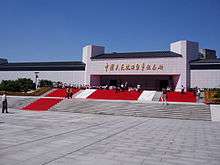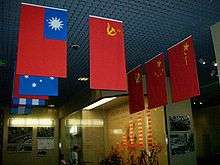Museum of the War of Chinese People's Resistance Against Japanese Aggression
| 中国人民抗日战争纪念馆 | |
 | |
| Established | 1987 |
|---|---|
| Location | 101 Chengnei St Fengtai District, Beijing |
| Coordinates | 39°51′08″N 116°13′33″E / 39.852276°N 116.225807°ECoordinates: 39°51′08″N 116°13′33″E / 39.852276°N 116.225807°E |
The Museum of the War of Chinese People's Resistance Against Japanese Aggression (simplified Chinese: 中国人民抗日战争纪念馆; traditional Chinese: 中國人民抗日戰爭紀念館; pinyin: zhōng guó rén mín kàng rì zhàn zhēng jì niàn guǎn) or Chinese People's Anti-Japanese War Memorial Hall is a museum and memorial hall in Beijing. It is the most comprehensive museum in China about the Sino-Japanese War.
The museum is located inside the Wanping Fortress near the Lu Gou Bridge (Marco Polo Bridge) in Beijing's Fengtai District, where the Japanese army waged the invading war. It was opened on the 50th anniversary of the outbreak of Second Sino-Japanese War on 7 July 1987.[1]
Since its opening up 1987, it has undergone three major and several smaller renovation in terms of the exhibits, the biggest of which was finished in 2005. A significant number of highly technological and scientific facilities have been added gradually, such as multimedia displays and video players.[2] The museum both aims at domestic and foreign visitors and has had several exhibitions outside China over the years.[3]
Origin and history
Supported by the Chinese Communist Party and the national leaders, the organization committee of the Chinese People's Anti-Japanese Memorial Hall was founded in October 1984. Almost 3 years later, on 7 July 1987, the memorial hall was completed and opened to the public on the 50th anniversary of the outbreak of Chinese Anti-Japanese War. Deng Xiaoping (Chinese: 邓小平), the then Chinese leader, performed the official opening. On July 7, 1997, the second phase of the project was finished. Jiang Zemin (Chinese: 江泽民), the General Secretary of the Communist Party at that time personally inscribed a slogan for it. On July 7, 2005, a large-scale exhibition named "Great Victory" was inaugurated.[4]
Since it was founded in 1987, the museum has undergone many developments and took up a new look gradually, especially after its largest renovation in 2005. During the course of its development, this museum has been expanded from 1,320 sq. meters to more than 6000 sq. meters.[5]
The reason behind the creation of the Museum is because economic reforms in China after 1970s “has caused an ideological gap that Beijing fears could lead to social and political fissure”, but “the store of political capital that is available to the CCP leadership from their own legacy of rule has nearly run dry”, especially when Mao also became a contested problematic figure, who no longer exist as the symbolic power that united China in the 1950s. The Museum then put forward the new official narrative with stronger rhetoric against Japan and a subsequent downgrading of fierce attacks on the Nationalist Party under Chiang Kai-shek during WWII. [6]
Layout of the hall
The Museum boasts 30,000 square meters and is divided up into 4 main halls. Visitors will first enter into the Main Hall, which shows the Japanese invasion from 1931 to 1945 in chronological order. Second is the Hall of Japanese Military Atrocities. As stated in the name, the Hall shows the atrocities the Japanese military committed against the Chinese people by using statistics and “descriptive displays.” Third is Hall of the People’s War, which describes the CCP’s strategic use of guerrilla warfare during the Japanese invasion of China and emphasizes the indispensable role played by the Chinese Communist Party in holding off the Japanese invasion. Last is the Hall of Martyrs of the War of Resistance, which is not a display like the other halls, but a monument to those martyrs. In the center of this hall is a statue of the Unknown Martyr. There are also four relief sculptures and name tablets that have the names of fallen soldiers. [7]
The museum uses various techniques to create a solemn atmosphere in the museum. The museum uses emotional language and varied tones to help emphasize the Japanese atrocities against the Chinese people.One of the most important and most uses technique is the use of dioramas. By creating the three-dimensional image, the atrocities the Japanese army committed against the Chinese Army and civilian people becomes more real to the people visiting the museum and evokes more emotions. [8]

The Hall of the Lugou Qiao Incident was opened on July 7, 1988. It is the first art hall which represents the Sino-Japanese War that employs techniques of painting, sculpture, magic lantern and acoustics to exhibit the theme. The hall, with a semicircle screen of 16.5 meters high and 50 meters long, plays documentaries of the Lugou Incident.
The exhibition halls of the museum also display some inscriptions from celebrities and some print, cartoons and picture posters of the Anti-Japanese War period.[9]
An exhibition named "Final Victory in the Anti-Japanese War"
The year of 2005 marks the 60th anniversary of the victory of Sino-Japanese War (Chinese: 中国抗日战争) as well as the world anti-fascist war. In February, 2005 the central government of China arranged series of memorial activities, to which the large-scale exhibition carried out in Chinese People's Anti-Japanese Memorial Hall, served as a significant prelude. Organized and supported by 8 departments of the central government and PLA, the exhibition kept the demands proposed by the CPC General Secretary Hu Jintao as its guiding doctrine, that is "Chinese people should cherish peace, work convertedly to create a bright future, while keeping the history in mind." Covering an area of 6346.6 sq.m., the exhibition consists of 8 sections, each of which concentrates on and puts emphasis on different phrases of Chinese People's Anti-Japanese war:
- the national crisis Chinese people faced in that time and the resure activities waged by patriots and people of insight.
- Cooperation of the Guomindang and the Communist Party of China in front of the invasion.
- Elaborates the main function of China's Communist Party.
- Behavior of the Japanese army toward Chinese people.
- Brave Chinese people
- Support from the international community.
- Contribution Chinese made to the world "in the victory in the anti-fascist war".
- Summary and lessons learned
Based on the lasting achievements of the research on the Chinese People's Anti-Japanese war, the exhibition demonstrated a great number of exhibits of various types, including 587 valuable photographys characterised by high definition, over 830 pieces of important relics, 22 groups of sculptures,14 pieces of oil paintings,10 scenes imitating the war and 165 pieces of assistubg exhibits. All of them, working together, show the Chinese actions during the Sino-Japanese War,in a comprehensive and objective way, sheds light on the historic meaning and crucial position of Chinese People's Anti-Japanese war in the world anti-fascist war. It also highlights the main function displayed by CCP in the war.
Transport connections
The museum is located inside the Wanping Fortress, near the Marco Polo bridge - the site of the Marco Polo Bridge Incident which brought the war from Manchuria into China proper. The fortress is situated in Beijing's southwestern Fengtai District.
The bus stop serving the fortress and the museum is called the Garden of sculptures of Sino-Japanese War. It is accessible by bus No. 624, 693, 983 from Wukesong Station and bus No. 301, 309, 339, 661, 662, 715 from Liuliqiao Station.
Important visitors
- Prime Minister of Japan Tomiichi Murayama visited the Hall on May 1995.
- CPC General Secretary Jiang Zemin visited the large-scale exhibition named Great Victory on 30 August 2005.
- On 14 August 2005 the General Secretary of the CPC central committee Hu Jintao visited the Hall.
- On 7 July 2005 chairman of the NPC standing committee Wu Bangguo visited the Hall.
- On 7 July 2014 General Secretary of the Communist Party Xi Jinping visited the Hall.
References
- ↑ Zhao Yanchen. "The Chinese People's Anti-Japanese Aggression War Memorial Hall". China Central Television. Retrieved 26 April 2012.
- ↑ http://www.1937china.org.cn/data/html/chinese/channel_111.html
- ↑ 中国人民抗日战争纪念馆简介. China Central Television (in Chinese). 22 September 2008. Retrieved 26 April 2012.
- ↑ 《带你走进博物馆:中国人民抗日战争纪念馆》
- ↑ 《中国人民抗日战争纪念馆》
- ↑ Rana Mitter,“Behind the Scenes at the Museum: Nationalism, History and Memory in the Beijing War of Resistance Museum, 1987-1997," The China Quarterly (2000), no. 161, 280
- ↑ Rana Mitter,“Behind the Scenes at the Museum: Nationalism, History and Memory in the Beijing War of Resistance Museum, 1987-1997," The China Quarterly (2000), no. 161, 281, 285, 287
- ↑ Rana Mitter,“Behind the Scenes at the Museum: Nationalism, History and Memory in the Beijing War of Resistance Museum, 1987-1997," The China Quarterly (2000), no. 161, 288
- ↑ http://www.chinaculture.org/library/2008-01/18/content_30634.html
External links
| Wikimedia Commons has media related to Memorial Hall of the Chinese People's War of Resistance Against Japanese Aggression. |